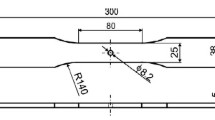Abstract
Enhancing the fatigue performance of aging aircraft structures is of significant concern for military and civil operators worldwide. One such method involves cold expanding fastener holes to exploit residual compressive stresses in the region surrounding the holes. The beneficial effect derived from this process depends on the magnitude and distribution of the residual stress surrounding each hole, therefore accurate identification of residual stress profiles is critical to the evaluation of the life of aircraft structure containing cold expanded fastener holes.
A 3-D Finite Element (FE) simulation of the hole cold expansion process was created. Advances in FE technology allowed this simulation to closely represent the physical expansion induced by the commercial split-sleeve process. The simulation included a post-expansion loading step that applied a remote tensile load to the cold expanded hole to estimate the interaction of the residual stresses and stress concentration of the open hole.
The FE simulations indicated a significant 3-D variation of the residual stress field, with notable variations through the thickness of the specimen. The magnitude of compressive residual stress was lowest at the mandrel entry face for the cold expansion process. It increased to a maximum at the mid-plane of the specimen, before decreasing to an intermediate value at the mandrel exit face. A threshold value of remote tensile load was identified, below which the residual stress field remained compressive at the bore of the hole. Over this threshold, the application of a remote tensile load created tensile stresses at the fatigue critical plane on the bore of the hole.
A constant amplitude fatigue testing programme was then conducted to ascertain the correlation of predicted residual stress fields and the fatigue properties of cold expanded fastener holes. For constant amplitude fatigue loading below the tensile threshold, small fatigue cracks initiated and then arrested, with no crack growth after 10 Million fatigue cycles. There was good correlation between the size and shape of these cracks and the residual stress field predicted by the FE simulation.
For constant amplitude fatigue loading above the threshold, similarly shaped fatigue cracks initiate and continue to propagate. Fractographic analysis showed initial crack growth was from the mandrel entry face. Propagation within the zone of compressive residual stress zone was complex. Once cracks had passed through the residual compressive stress zone, they rapidly transitioned to corner cracks and then to through cracks, which propagated to failure.
Access this chapter
Tax calculation will be finalised at checkout
Purchases are for personal use only
Preview
Unable to display preview. Download preview PDF.
Similar content being viewed by others
References
McClung, R.C.: A literature survey on the stability and significance of residual stresses during fatigue. Fatigue & Fracture of Engineering Materials & Structures 30, 173–205 (2007)
Stow, K.: SPAR Aerospace Fatigue Improvement Modification Cold Expansion Research Reort for RNZAF C-130 Programme. Fatigue Technology Inc. FTI Technical Report # 195386 (2006)
Fatigue Technology Inc. FTI Process Specification 8101D - Cold Expansion o Holes Using the Standard Split Sleeve System and Countersink Cold Expansion, CsCX (2002)
West Coast industries. Engineering Handout, Split Sleeve Coldworking Holes. WCI-EH-9201-4.1
Houghton, S.J.: Finite Element Analysis of the Cold Expansion of Aircraft Fastener Holes. Auckland: Defence Technology Agency, DTA Report 296 (2010)
Kokaly, M., Ransom, J.S., Restis, J.H., Reid, L.: Observations and Analysis of Fatigue Crack Growth from Cold Expanded Holes. In: Proceedings of the 8th Joint NASA/FAA/DoD Conference on Aging Aircraft, Pam Springs, California (2005)
Zvyagintsev, V.: RNZAF-FIM3-01 Rev 0 Ch 0 Fatigue Improvement Modification - Verification Data. L3 Communications Spar Aerospace (2007)
Dassault Systemes Simulia Corp. ABAQUS User Documentaion Version 6.9-EF (2009)
Houghton, S.J.: Identifying Accurate Material Sress Strain Curves for Non-Linear FEA Using Tensile Testing. Auckland: Defence Technology Agency, DTA Technical Note 2009/6 (2009)
Barter, S.A., Wanhil, R.J.H.: Marker Loads for Quantitative Fractorgraphy (QF) of Fatigue in Aerospace Alloys. National Aerospace Laboratory, Netherlands, NLR-TR-2008-644 (2008)
RNZAF. Hercules Aircfrat C-130H Structural Repair Manual, NZAP 6211.001-3 (1997)
Author information
Authors and Affiliations
Editor information
Editors and Affiliations
Rights and permissions
Copyright information
© 2011 Springer-Verlag Berlin Heidelberg
About this paper
Cite this paper
Houghton, S.J., Campbell, S.K., James, A.D. (2011). Investigations into the Fatigue Enhancement Provided by the Hole Cold Expansion Process Using Accurate 3D FEA Simulations and Fatigue Testing. In: Komorowski, J. (eds) ICAF 2011 Structural Integrity: Influence of Efficiency and Green Imperatives. Springer, Dordrecht. https://doi.org/10.1007/978-94-007-1664-3_65
Download citation
DOI: https://doi.org/10.1007/978-94-007-1664-3_65
Publisher Name: Springer, Dordrecht
Print ISBN: 978-94-007-1663-6
Online ISBN: 978-94-007-1664-3
eBook Packages: EngineeringEngineering (R0)




